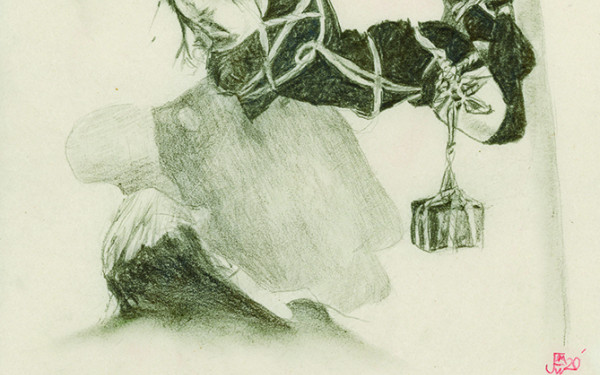Wicked Mmm Makes Lingerie on a Spectrum
Montreal Couple’s Business Is Sexy and Comfortable for Everyone
Masha Smushkevitch and Will Desjardins think that all bodies should get to wear nice panties. The partners are co-founders of Wicked Mmm, a Montreal-based lingerie brand bringing handmade underwear for everyone.
Masha Smushkevitch and Will Desjardins think that all bodies should get to wear nice panties. The partners are co-founders of Wicked Mmm, a Montreal-based lingerie brand bringing handmade underwear for everyone.
“For the most part, I design stuff without thinking this is for a male body or a female body,” said Smushkevitch. “The cut will be determined by who orders it and how they want it.”
The brand’s uniqueness lies in both its style and who it is designed for. Since 2016, Wicked Mmm has taken the materials and aesthetic you might expect to find in lingerie usually marketed to women such as lace, sheer fabrics, and soft lines. Their designs are made available in three cuts tailored to fit all anatomies: the “bulge,” the “tuck,” and the “flat.”
“We had large discussions about that in the beginning, about how to navigate that and categorize our stuff without pigeonholing it into for men or women,” said Desjardins.
The brand started by offering an alternative to what would generally be considered sexy for masculine bodies, and gradually evolved into their current offering of cuts made to fit all bodies. “You don’t have to be stuck in the aesthetic that society tells you should like, and if you don’t feel like it represents you, well ‘too bad,’” said Smushkevitch.
Masha Smushkevitch is the brand’s seamstress. She studied theater at Concordia with a focus on costume design and gained experience through freelance sewing contracts. She had never made underwear before Wicked Mmm, and now handmakes all their models in their Montreal studio while Desjardins focuses on sales and administrative tasks.
“I’m part of a community with a lot of queer people in it, a lot of people who fall somewhere in the middle of the gender spectrum,” said Smushkevitch. But as time designing underwear passed, she realized that gender was not all that meaningful to her work. “It’s more that we do have particular anatomies we need to accommodate when making clothes.”
She likes to shop for materials locally, making sure that the fabrics meet her requirements for quality and comfort. Lace is still very present in their collection, but Smushkevitch also likes to experiment with other breathable materials such as bamboo.
“I like clean lines, I like symmetry, without a lot of frills,” said Smushkevitch. “I want it to be something people can wear because it feels good, not for a special occasion or their partner, but for themselves.”
The couple also owns Tension, a local school offering Shibari classes, teaching the ancient Japanese art of rope bondage. Desjardins wanted something nice to wear for his performances. After being unable to find something matching what he desires in terms of style and quality while shopping in Montreal, Smushkevitch realized that she could probably make him what he had in mind.
“You don’t have to be stuck in the aesthetic that society tells you should like, and if you don’t feel like it represents you, well ‘too bad,’” — Masha Smushkevitch
Desjardins received a lot of positive reactions when he wore his custom-made panties to a performance. Their friends started ordering pairs. The couple decided to open an Etsy shop with the original model and a few other pieces they had designed—more orders came in. Later, they created their own website to host their online store.
“It started out with just traditionally feminine underwear for male-bodied people” said Smushkevitch. “And then I developed a bunch of different styles and started to also make things for myself and put that up [on the website].”
“We’ve evolved from lingerie for people with packages, to lingerie for people of all genders,” said Desjardins.
The aesthetic and practicality of the design is also why Tristan Ginger, a burlesque performer wears Wicked Mmm’s lingerie for their shows. “It’s the perfect blend. It’s a perfect fit, lacey, feminine, yet there’s a pouch, no tucking necessary. It’s like the prettiest thing surrounding the masculine,” said Ginger.
Smushkevitch and Desjardins saw Ginger perform and asked if they would be interested in being in the brand’s first fashion show. Since then, they’ve kept modeling for Wicked Mmm and have a developed a strong friendship and professional relationship with the two co-owners.
“It’s a two-way street where we’re fully supportive and believe in each other,” said Ginger. I’ve worked with them for a few years now, and love to hang with them too.”
The philosophy behind their products has allowed them to keep tight-knit relations with their customers. For the couple, this positive feedback about their work also contributes to their motivation to pursue the brand.
“There was this customer, she’s a trans woman and she expressed that getting this underwear helped her dealing with gender dysphoria. It’s stuff I would have never dreamed about doing for people, but it’s very touching to hear that,” said Smushkevitch.
So far the process has not changed, Smushkevitch still creates most of her designs for herself, her partner, or one of their friends when they have a special request. If they like the result, then it will likely become available for order on their website.
They are currently planning the opening of their first store in Montreal. Located at the corner of Ste. Catherine St. E and Wolfe St., it will serve as a retail space for Wicked Mmm and as the studio for their Shibari school. “I’m very excited to get an actual physical shop, where people can come, look and try things on,” said Smushkevitch.
The brand may have started as a very personal venture for them but has now grown into a strong business with a dedicated social media following. “It takes time to build a brand and we’re finally at that point where we’re a little bit more visible and people recognize us, it was a lot of work to get to that place,” said Smushkevitch.


_600_832_s.png)



